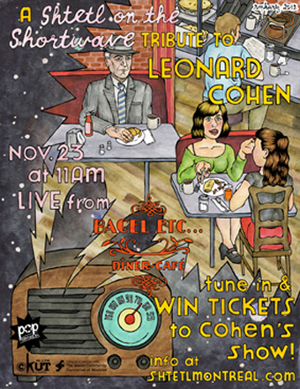
In this series, author Lamed Resh addresses a commonly asked question about his life’s story: When did you abandon Chassidic faith? In true Talmudic fashion, Lamed responds to this simple question with a complicated answer. He turns to Sigmund Freud’s psychosexual theory of development and traces the origins of his heresy through four critical phases: Oral, Anal, Phallic, and Genital. In this episode, Lamed recounts the anal phase of his progression from Chassid to apikores1.
The Anal Phase: Let My People Go
Excrement is such a foul and offensive substance that we experience immense displeasure at the sight of it, even though we encounter it daily. It is therefore surprising that feces are a routine source of gratification in our lives. Every time you pinch a loaf, your body releases endorphins, congratulating you for performing a vital biological function.
Although getting rid of shit is generally an easy affair, holding on to it poses a considerably greater challenge, particularly for individuals at the tail ends of the developmental spectrum.
Yes, life both begins and ends in the struggle for bowel control, but it is only the first bout of toilet training that carries psychosexual significance. Freud referred to it as the anal conflict, and considered it so critical to development that it foreshadowed our lifelong ability to “handle our shit.”
As you will soon see, Chassidic rebellion also progresses with an anal phase of development, marked by the very same quest for control. It is during this phase that heretics develop the independence to challenge religious customs, facilitating their release from the anus of religious orthopraxy.
But we’ll get to that soon, Dear Reader. First, a few teachings from Reb Freud are in order.
Sigmund believed that sexual gratification plays an essential role in toilet training, and proposed that such pleasure climaxes when poop is expelled following a prolonged period of retention. In the contemporary blogosphere, this experience is known as poophoria – the state of arousal that both precedes and follows the expulsion of toxic waste.
Freud suggested that poophoria is important to toilet training (and psychological growth more generally), because it motivates toddlers to delay gratification, to squeeze their tiny anuses tighter and tighter, holding on to their poop longer and longer.
Whereas the thrill of bowel control typically advances the toilet training process, it is also what ultimately derails it. Under extreme conditions—such as strict or permissive parenting—toddlers become fixated on the pleasures of retention at the expense of letting go, and they endure many accidents as a result. Later in life, they develop into anal-retentive adults: neurotic, stubborn, and controlling, with their sexual desire forever lodged in the tension of their tightly clenched poopenshaften.
Much like diaper-soiling toddlers, anal-retentive adults lack a personal sense of control. They are unable to self-regulate and experience anxiety in uncertain situations. To cope with the ambiguities of everyday life, they turn to external sources of control, finding comfort in institutional rules and structure.
If you grew up within the Jewish faith, you likely recognize Freud’s anal archetype. Jewish practice is so persnickety that it naturally attracts individuals with a penchant for rule-governed behaviour. The Halacha, or Code of Jewish Law, includes stepwise instructions for all matters of conduct, including regulations for bathing, toenail clipping, and dressing. First your right limb, then your left. The Halacha is thus attractive to the anal-retentive Chassids because it removes the discomfort of moral ambiguity and relieves them from ever having to grapple with questions of right and wrong.
It is fitting that my release from the clutches of the halacha—the so called anal tradition—began during the Passover Seder when I was 13 years old. Passover is a holiday that commemorates the Jewish exodus from Egypt, and the Seder is a meal designed to foster the retelling of that story. The Seder is so heavily legislated with halachic regulations that even the most seasoned Rabbis follow a manual to guide them through the painstaking ritual.
One such regulation requires drinking a goblet of wine at four marked points during the meal. Each time, the chalice must be filled to the brim, and the observant are instructed to recline while drinking. The practice is intended to evoke our sense of liberation from Egypt: Once we were slaves in Egypt, but now we are free to guzzle wine like assholes. At my 57532 Seder, however, I was less concerned about my ancestor’s escape from Mitzrayim3 than I was about soiling my freshly pressed shirt.
I was instructed to drink like a free man—to lean back and gulp down a brimming goblet of wine—but with the psychomotor control of a typical 13 year old, I was not confident that I could pull off the part. In a rare cerebral moment, I betrayed the reclining ritual, and leaned over my place setting to drink from my Passover chalice. When my parents insisted that I recline, I protested that if I were truly liberated, I should be free to deny the obligation, and that by disobeying the halacha in this instance, I was in fact being faithful to its intended purpose.
As a 32 year old man, I regret my chutzpah, but I also recognize its significance to the healthy progression of my heresy. It was with such acts of defiance that the foundations of my faith began to creak and my transgressions became more personal, reasoned, and autonomous.
Had I lacked the independence to challenge the rationale of halachic obligations, I would have failed the anal conflict, and developed lifelong issues of religious control. I would have turned to halachic instruction to assuage the anxiety of moral ambiguity, and would be forever fated to serve Hashem3 with a tightly clenched tuchus4.
Instead, I observed Judaism on my own terms. I had not yet questioned the merit of my Chasidic rearing, but I was sufficiently flexible to negotiate its orthopraxy. And with every wrinkle uncovered in the fabric of Jewish law, I developed a more personal sense of control.
And so it was that I surmounted the anus of my Chassidic heresy. But though I have come to the tail-end of this phase, Dear Reader, the story of my rebellion does not stop here. Over the next few years, my rebellion will take a dark turn. There will be conflict and turmoil. A messiah will die. But from the ashes, a phallus will rise….
1apikores is the Yiddish term for a heretic.
2 5753 refers to the year of the Jewish calendar that roughly coincides with 1993.
3 Mitzrayim is the Hebrew word for Egypt. It also means “a narrow place”.
4 Hashem, which literally means “the name,” is Hebrew for God.
5 tuchus is the Yiddish term for gluteous maximus, aka one’s bum.
__________________________________________
Lamed Resh hails from the streets of Cote-des-Neiges in Montreal, where he attended Yeshiva as a child. LR’s journey to relinquish his Chassidic faith for a secular life has been featured on local and international television. He is now studying for his Doctorate in Philosophy as part of a broader effort to demystify human experience for himself and others.
The illustration for this story of a Jew all tied up in his tefilin was done by Jacob Aspler. Check out his other work.





